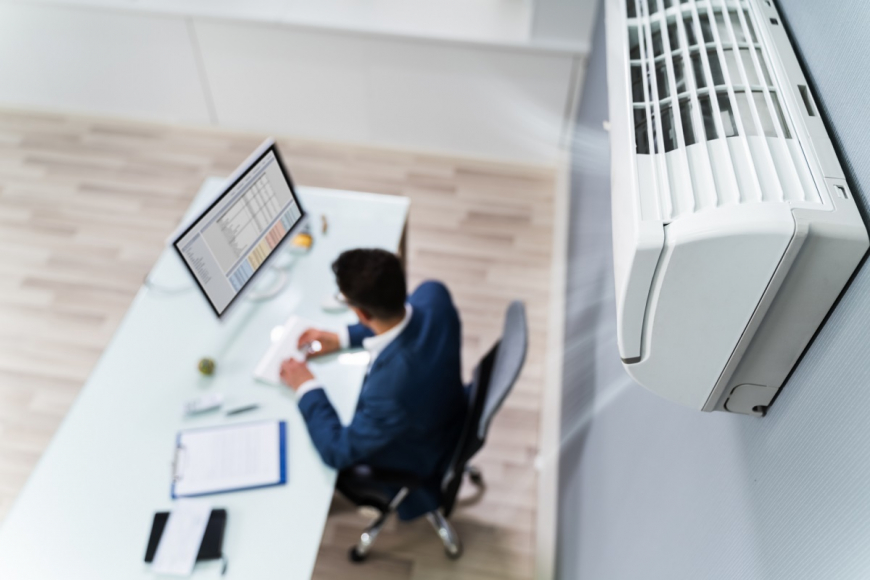While indoor air quality (IAQ) in offices was always important, it is now at the forefront of many government COVID-19 requirements and recommendations for offices.
While most office-workers have been working from home for much of this year, there is a slow but growing trend towards opening office spaces for limited numbers of employees to gather and collaborate. Employers recognize the value of in-person meetings for building stronger teams and sparking innovation. Of course, going into the office during a pandemic is quite different. We now know that COVID-19 spreads through respiratory droplets and aerosols that are produced through talking and breathing. While indoor air quality (IAQ) in offices was always important, it is now at the forefront of many government COVID-19 requirements and recommendations for offices.
Compounding the COVID-19 IAQ issues are the many wildfires that are also impacting indoor air quality. At the same time, many of us are starting to spend more time indoors with winter weather in northern regions and indoor holiday gatherings. At our October 2020 virtual EHSxTech meeting, 20+ EHS professionals from leading technology companies discussed the basics of IAQ and COVID-19-specific aspects for safely opening offices. We were joined by the Global Health and Safety Manager from a well known multinational tech company to discuss the importance of this topic. As a bonus, Theresa McCollom, CIH and aerosol subject matter expert from Antea Group, educated our group on some of the false advertising claims being put forth by manufacturers to sell home air purifiers during this time of COVID-19.
"In these times of uncertainty and continuous change, it’s great to have a forum to come together to discuss topics, learnings, and insights on this evolving situation and how we can continue to improve and support each other as industry peers."
- Peylina Chu, Vice President / Technology Industry Leader, Antea Group
A few key takeaways from the EHSxTech event were:
- Although everyone acknowledged the importance of indoor air quality, only 30% had written IAQ programs.
- The most commonly measured parameters when looking at indoor air quality were temperature, humidity, particles, and carbon dioxide.
- The most common changes to HVAC systems in response to COVID-19 were increasing air changes and percentage of outside air intake, and installing MERV 13 or HEPA filters
Indoor Air Quality – The Basics
Why is indoor air quality important? In addition to discomfort, there are several health effects and symptoms related to IAQ including hypersensitivity, asthma, infections, sick building syndrome, psychosomatic symptoms, multiple chemical sensitivity, and greater absenteeism. In addition, poor indoor air quality can lead to decreased cognitive function, lower decision-making performance, and decreased productivity, resulting in real impacts to your business.
The common parameters for monitoring indoor air quality in offices are carbon dioxide, temperature, humidity, volatile organic compounds (VOCs), formaldehyde, products of combustion, ozone, particulate matter, and biological contaminants. There are national and international IAQ standards and guidelines put forth by the American Society of Heating, Refrigerating, and Air-Conditioning Engineers (ASHRAE), the Environmental Protection Agency (EPA), the U.S. Green Building Council (USGBC), the Federal Emergency Management Agency (FEMA), and the World Health Organization (WHO) for these parameters. Building engineers and EHS managers use these standards and guidelines to determine if changes need to be made to the HVAC system to improve air quality and to determine if there are sources of contaminants that need to be removed from the office.
COVID-19 and Indoor Air Quality
MERV, HEPA, ISO 16890, EN 1822 – Have you heard these terms but don’t know what they mean? We are here to help!
MERV, HEPA, ISO 16890, EN 1822 are equipment references and standards for the protection or improvement of indoor air quality. These terms have become increasingly common as building and HVAC engineers and EHS managers are looking for ways to open offices safely during the pandemic.
MERV, or Minimum Efficiency Reporting Value, is a term applied to an HVAC filter. It reflects the filter’s ability to capture particles between 0.3 and 10 microns, especially important for capturing COVID-19 aerosols. The higher the MERV rating, the higher the collection efficiency.
HEPA filter, or High-Efficiency Particulate Air filter, is an official term of the U.S. Department of Energy and bases collection efficiency on the hardest particle size to capture - 0.3 microns. A HEPA filter will collect 99.97% of 0.3-micron particles.
ISO 16890 is an international standard and defines the Particulate Matter Efficiency Classification and also takes into consideration if the media filter is charged (intended to increase collection efficiency). ePM1 and ePM2.5 are common classifications and refer to electronically charged filters that capture particulate matter sizes of 0.3 to 1 micron and 0.3 to 2.5 microns, respectively. Over time, the charged media decreases in efficiency and must be changed.
EN1822 is a European Union standard for filter classification that groups filters into Class E, Class H, and Class U.
- Class E= EPA
- Class H=HEPA
- Class U= ULPA (ultra-low particulate air)
ASHRAE and CDC have put forth the following COVID-19 guidance for indoor air quality. The goal is to decrease exposure to infectious droplets and aerosols.
General guidance (non-healthcare):
- Increase outdoor air ventilation (disable demand-controlled ventilation and open outdoor air dampers to 100% (as outdoor conditions permit)
- Improve central air filtration to MERV-13 or the highest possible
- Keep systems running (24/7 if possible)
- Consider a pre- or post-occupancy flush with outdoor air (enough time to achieve three air changes)
- With consideration to airflow patterns (clean to less clean air movement), consider the use of portable HEPA filters, especially in higher-risk areas
- Consider upper room UVGI devices
- Consider the not using or removing ceiling and personal fans
There are a few states and counties that are proposing additional IAQ requirements and/or guidance, so make sure to check your local agencies.
Bonus Round: Home Air Purifiers
Have you seen an increasing number of ads for home air purifiers and thought about buying one? Well, read this before you buy!
Be wary of marketing claims for portable air purifiers that “destroy VOCs and bioaerosols” or have verbiage like “HEPA Type” or “permanent HEPA” as these terms are not related to how well the filter is designed or operates. When considering a portable air filtration unit, it is recommended to look for verbiage such as “True HEPA” or “Absolute HEPA.” A MERV rating of 17 or higher is typically considered a high-efficiency particulate air filter (HEPA).
Portable units with a minimum collection efficiency of at least 0.3 microns can theoretically remove greater than 99.9% of air contaminants larger than 0.3 microns. Portable units are often equipped with additional technology claiming effectiveness in eliminating bacterial, viral, or other hazards (ionization, PCO/PECO, etc.). However, this extra technology often does not have sound science backing up the claims of efficiency. Other units may come with enticing features. For example, some filters may be marketed as washable, however, washing could cause damage to the collection ability.
EHSxTech Industry Group
EHSxTech presents a unique opportunity for tech industry professionals to explore global opportunities to improve environment, health, safety, and sustainability performance, and talk through their unique issues in a collaborative, non-competitive forum.
Learn more about EHSxTechWant more news and insights like this?
Sign up for our monthly e-newsletter, The New Leaf. Our goal is to keep you updated, educated, and even a bit entertained as it relates to all things EHS and sustainability.
Get e-NewsletterHave any questions?
Contact us to discuss your environment, health, safety, and sustainability needs today.





